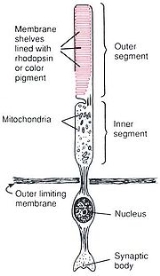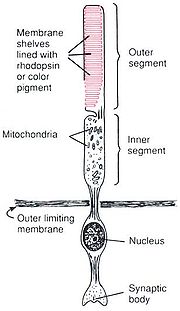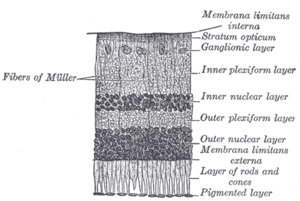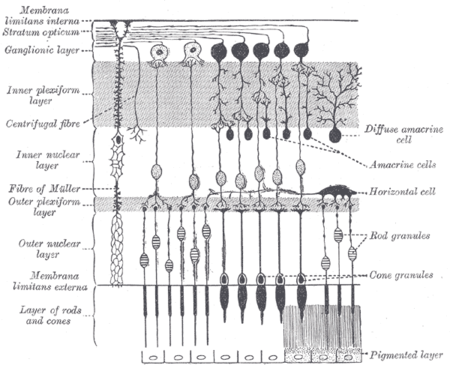
External limiting membrane
Encyclopedia
The external limiting membrane (or outer limiting membrane) is one of the ten distinct layers of the retina
of the eye
. It has a network-like structure and is situated at the bases of the rods
and cones
.



Retina
The vertebrate retina is a light-sensitive tissue lining the inner surface of the eye. The optics of the eye create an image of the visual world on the retina, which serves much the same function as the film in a camera. Light striking the retina initiates a cascade of chemical and electrical...
of the eye
Human eye
The human eye is an organ which reacts to light for several purposes. As a conscious sense organ, the eye allows vision. Rod and cone cells in the retina allow conscious light perception and vision including color differentiation and the perception of depth...
. It has a network-like structure and is situated at the bases of the rods
Rod cell
Rod cells, or rods, are photoreceptor cells in the retina of the eye that can function in less intense light than can the other type of visual photoreceptor, cone cells. Named for their cylindrical shape, rods are concentrated at the outer edges of the retina and are used in peripheral vision. On...
and cones
Cone cell
Cone cells, or cones, are photoreceptor cells in the retina of the eye that are responsible for color vision; they function best in relatively bright light, as opposed to rod cells that work better in dim light. If the retina is exposed to an intense visual stimulus, a negative afterimage will be...
.
Additional images



External links
- http://www.med.uiuc.edu/histo/small/atlas/objects/126.htm
- Slide at uc.edu
- http://www.kumc.edu/instruction/medicine/anatomy/histoweb/eye_ear/eye12.htm
- http://education.vetmed.vt.edu/Curriculum/VM8054/EYE/RETINA.HTM

